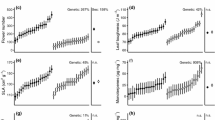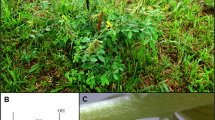Abstract
To determine the influence of plant genetic variation on community structure of insect herbivores, we examined the abundances of 14 herbivore species among six genetic classes of willow: Salix eriocephala, S. sericea, their F1 and F2 interspecific hybrids, and backcross hybrids to each parental species. We placed 1-year-old plants, grown from seeds generated from controlled crosses, in a common garden. During the growing season, we censused gall-inducing flies and sawflies, leaf-mining insects, and leaf-folding Lepidoptera to determine the community structure of herbivorous insects on the six genetic classes. Our results provided convincing evidence that the community structure of insect herbivores in this hybrid willow system was shaped by genetic differences among the parental species and the hybrid genetic classes. Using MANOVA, we detected significant differences among genetic classes for both absolute and relative abundance of herbivores. Using canonical discriminant analysis, we found that centroid locations describing community structure of the insect herbivores differed for each genetic class. Moreover, the centroids for the four hybrid classes were located well outside of the range between the centroids for the parental species, suggesting that more than additive genetic effects of the two parental species influenced community formation on hybrid classes. Line-cross analysis suggested that plant genetic factors responsible for structuring the herbivore community involved epistatic effects, as well as additive and dominance effects. We discuss the ramifications of these results in regard to the structure of insect herbivore communities on plants and the implications of our findings for the evolution of interspecific interactions.


Similar content being viewed by others
References
Anderson E (1949) Introgressive hybridization. Wiley, New York
Argus GW (1986) The genus Salix (Salicaceae) in the southeastern United States. Syst Bot Monogr 9:1–170
Armbruster P, Bradshaw WE, Holzapfel CM (1997) Evolution of the genetic architecture underlying fitness in the pitcher-plant mosquito, Wyeomyia smithii. Evolution 51:451–458
Arnold ML (1997) Natural hybridization and evolution. Oxford University Press, New York
Berenbaum MR, Zangerl AR (1998) Population-level adaptation to host-plant chemicals: the role of cytochrome P450 monooxygenases. In: Mopper S, Strauss SY (eds) Genetic structure and local adaptation in natural insect populations. Chapman and Hall, New York, pp 91–112
Boecklen WJ, Spellenberg R (1990) Structure of herbivore communities in two oak (Quercus spp.) hybrid zones. Oecologia 85:92–100
Cavalli LL (1952) An analysis of linkage in quantitative inheritance. In: Reeve ECR, Waddington CH (eds) Quantitative inheritance. Her Majesty’s Stationary Office, London, UK, pp 135–144
Collins JP (2003) What can we learn from community genetics? Ecology 84:574–577
Denno RF, McClure MS, Ott JR (1995) Interspecific interactions in phytophagous insects: competition reexamined and resurrected. Annu Rev Ecol Syst 40:297–331
Dickson LL, Whitham TG (1996) Genetically based plant resistance traits affect arthropods, fungi, and birds. Oecologia 106:400–406
Dungey HS, Potts BM, Whitham TG, Li HF (2000) Plant genetics affects arthropod community richness and composition: evidence from a synthetic eucalypt hybrid population. Evolution 54:1938–1946
Edmands S (1999) Heterosis and outbreeding depression in interpopulation crosses spanning a wide range of divergence. Evolution 53:1757–1768
Eisenbach J (1996) Three-trophic-level interactions in cattail hybrid zones. Oecologia 105:258–265
Ekbom BS (1977) Development of a biological control program for greenhouse whiteflies (Trialurodes vaporarium Westwood) using its parasite Encarsia formosa (Gahan) in Sweden. J Appl Entomol 84:145–54
Ellstrand NC, Whitkus R, Rieseberg LH (1996) Distribution of spontaneous plant hybrids. Proc Natl Acad Sci-Biol 93:5090–5093
Faeth SH (1986) Indirect interactions between temporally separated herbivores mediated by the host plant. Ecology 67:479–494
Fenster CB, Galloway LF (2000a) Inbreeding and outbreeding depression in natural populations of Chamaecrista fasciculata (Fabaceae). Conserv Biol 14:1406–1412
Fenster CB, Galloway LF (2000b) Population differentiation in an annual legume: genetic architecture. Evolution 54:1157–1172.
Fenster CB, Galloway LF, Chao L (1997) Epistasis and its consequences for the evolution of natural populations. Trends Ecol Evol 12:282–286
Floate KD, Whitham TG (1995) Insects as traits in plant systematics: their use in discriminating between hybrid cottonwoods. Can J Bot 73:1–13
Floate KD, Martinsen G, Whitham TG (1997) Cottonwood hybrid zones as centers of abundance for gall aphids in westerns North America: importance of relative habitat size. J Anim Ecol 66:179–188
Fritz RS (1990) Variable competition between insect herbivores on genetically variable host plants. Ecology 71:2008–2011
Fritz RS (1992) Community structure and species interactions of phytophagous insects on resistant and susceptible host plants. In Fritz RS, Simms EL (eds) Plant resistance to herbivores and pathogens: ecology, evolution, and genetics. University of Chicago Press, Chicago, pp 240–277
Fritz RS (1995) Direct and indirect effects of plant genetic variation on enemy impact. Ecol Entomol 20:18–26
Fritz RS, Kaufman SR (1993) Variable enemy impact at three scales: herbivore species, plant species, and plant genotype. Oikos 68:463–472
Fritz RS, Nobel J (1990) Host plant variation in mortality of the leaf-folding sawfly on the arroyo willow. Ecol Entomol 15:25–35
Fritz RS, Price PW (1988) Genetic variation among plants and insect community structure: willows and sawflies. Ecology 69:845–856
Fritz RS, Nichols-Orians CM, Brunsfeld SJ (1994) Interspecific hybridization of plants and resistance to herbivores: hypotheses, genetics, and variable responses in a diverse herbivore community. Oecologia 97:106–117
Fritz RS, Roche BM, Brunsfeld SJ, Orians CM (1996) Interspecific and temporal variation in herbivore responses to hybrid willows. Oecologia 108:121–129
Fritz RS, McDonough SE, Rhoads AG (1997) Effects of plant hybridization on herbivore-parasitoid interactions. Oecologia 110:360–367
Fritz RS, Roche BM, Brunsfeld SJ (1998) Genetic variation in resistance of hybrid willows to herbivores. Oikos 83:117–128
Galloway LF, Fenster CB (2000) Population differentiation in an annual legume: local adaptation. Evolution 54:1173–1181.
Grant V (1981) Plant speciation. Colombia University Press, New York
Hardig TM, Brunsfeld SJ, Fritz RS, Morgan M, Orians CM (2000) Morphological and molecular evidence for hybridization and introgression in a willow (Salix) hybrid zone. Mol Ecol 9:9–24
Harrison R (ed) (1993) Hybrid zones and the evolutionary process. Oxford University Press, New York
Hatfield T (1997) Genetic divergence in adaptive characters between sympatric species of stickleback. Am Nat 149:1009–1029
Hayman BI (1958) The separation of epistatic from additive and dominance variation in generation means. Heredity 12:371–390
Holt RD, Lawton JH (1994) The ecological consequences of shared natural enemies. Annu Rev Ecol Syst 25:495–520
Huberty CJ (1994) Applied discriminant analysis. Wiley, New York
Hufbauer R, Via S (1999) Evolution of an aphid-parasitoid interaction: variation in resistance to parasitism among aphid populations specialized on different plants. Evolution 53:1435–1445
Hunter MD, Price PW (1992) Playing chutes and ladders: heterogeneity and the relative roles of bottom-up and top-down forces in natural communities. Ecology 73:724–732
Karban R (1992) Plant variation: its effects on populations of herbivorous insects. In: Fritz RS, Simms EL (eds) Plant resistance to herbivores and pathogens: ecology, evolution, and genetics. University of Chicago Press, Chicago, pp195–215
Keim P, Paige KN, Whitham TG, Lark KG (1989) Genetic analysis of an interspecific swarm of Populus: occurrence of unidirectional introgression. Genetics 123:557–565
Lair KP, Bradshaw WE, Holzapfel CM (1997) Evolutionary divergence of the genetic architecture underlying photoperiodism in the pitcher-plant mosquito, Wyeomyia smithii. Genetics 147:1873–1883
Lynch M, Walsh B (1998) Genetics and analysis of quantitative traits. Sinauer Associates, Sunderland, Mass.
Maddox GD, Root RB (1990) Structure of the encounter between goldenrod (Solidago altissima) and its diverse insect fauna. Ecology 71:2115–2124
Mather K, Jinks JL (1982) Biometrical genetics: the study of continuous variation. Chapman and Hall, New York
Mattson WJ, Haack RK, Birr BA (1996) F1 hybrid spruces inherit the phytophagous insects of their parents. Mattson WJ, Niemela P, Rousi M (eds) Dynamics of forest herbivory: quest for pattern and principle. USDA, North Central Forest Experiment Station, Forest Service, St Pauls, pp 142–149
Mopper S, Strauss SY (1998) Genetic structure and local adaptation in natural insect populations. Chapman and Hall, New York
Mopper S, Whitham TG, Price PW (1990) Plant phenotype and interspecific competition between insects determine sawfly performance and density. Ecology 71:2135–2144
Moran NA, Whitham TG (1990) Interspecific competition between root-feeding and leaf-galling aphids mediated by host-plant resistance. Ecology 71:1050–1058
Morrow PA, Whitham TG, Potts BM, Ladiges P, Ashton DH, Williams JB (1994) Gall-forming insects concentrate on hybrid phenotypes of Eucalyptus. In: Price PW, Mattson WJ, Baranchikov YN (eds) The ecology and evolution of gall-forming insects. General Technical Report GTR NC-174. U.S. Forest Service North Central Forest Experiment Station, St Paul’s, pp 121–134
Mosseler A (1989) Interspecific pollen-pistil incongruity in Salix. Can J For Res 19:1161–1168
Mosseler A (1990) Hybrid performance and species crossability relationships in willows (Salix). Can J Bot 68:2329–2338
Mosseler A, Papadopol CS (1989) Seasonal isolation as a reproductive barrier among sympatric Salix species. Can J Bot 67:2563–2570
Paige KN, Capman WC (1993) The effects of host-plant genotype, hybridization and environment on gall aphid attack and survival in cottonwood: the importance of genetic studies and the utility of FRLP’s. Evolution 47:36–45
Preszler RW, Boecklen WJ (1994) A three-trophic-level analysis of the effects of plant hybridization on a leaf-mining moth. Oecologia 100:66–73
Price PW, Bouton CE, Gross P, McPherion BA, Thompson JN, Weis AE (1980) Interactions among three trophic levels: influence of plants on interactions between insect herbivores and natural enemies. Annu Rev Ecol Syst 11:41–65
Rice WR (1989) Analyzing tables of statistical tests. Evolution 43:223–225
Rieseberg LH (1995) The role of hybridization in evolution: old wine in new skins. Am J Bot 82:944–953
Rieseberg LH, Wendel JF (1993) Introgression and its consequences in plants. In: Harrison R (ed) Hybrid zones and the evolutionary process. Oxford University Press, New York, pp 70–109
Rieseberg LH, Sinervo B, Linder CR, Ungerer MC, Arias DM (1996) Role of gene interactions in hybrid speciation: evidence from ancient and experimental hybrids. Science 272:741–745
SAS (1990) SAS user’s guide: statistics. SAS Institute, Cary, N.C.
Stace CA (1987) Hybridization and the plant species. In: Urbanska KM (ed) Differentiation patterns in higher plants. Academic Press, New York, pp115–127
Stebbins GL (1959) The role of hybridization in evolution. Proc Am Phil Soc 103:231–251
Thompson JN (1994) The Coevolutionary Process. The University of Chicago Press, Chicago
Thompson JN (1999) What we know and do not know about coevolution: insect herbivores and plants as a test case. In: Olff H, Brown VK, Drent RH (eds) Herbivores: between plants and predators. Blackwell Science, Oxford, UK, pp 7–30
Via S (1991) The genetic structure of host plant adaptation in a spatial patchwork: demographic variability among reciprocally transplanted pea aphid clones. Evolution 45:827–852
Whitham TG, Morrow PA, Potts BM (1991) Conservation of hybrid plants. Science 254:779–780
Whitham TG, Morrow PA, Potts BM (1994) Plant hybrid zones as centers of biodiversity: the herbivore community of two endemic Tasmanian eucalypts. Oecologia 97:481–490
Whitham TG, Martinsen GD, Floate KD, Dungey HS, Potts BM, Keim P (1999) Plant hybrid zones affect biodiversity: tools for a genetic-based understanding of community structure. Ecology 80:416–428
Whitham TG, Young WP, Martinsen GD, Gehring CA, Schweitzer JA, Shuster SM, Wimp GM, Fischer DG, Bailey JK, Lindroth RL, Woolbright S, Kuske CR (2003) Community and ecosystem genetics: a consequence of the extended phenotype. Ecology 84:559–573
Whitlock MC, Phillips PC, Moore FBG, Tonsor SJ (1995) Multiple fitness peaks and epistasis. Annu Rev Ecol Syst 26:601–629
Wold EN, Marquis RJ (1997) Induced defense on white oak: effects on herbivores and consequences for the plant. Ecology 78:1356–1369
Zar JH (1984) Biostatistical analysis. Prentice-Hall, Englewood Cliffs, New Jersey
Acknowledgements
Funding by NSF grant BSR 96–15038 and by the Class of ‘42 Environmental Sciences Fund at Vassar College to R.S.F. and NSF grant DEB 0127369 to C.G.H. supported this research. We thank Len and Ellie Sosnowski, who have permitted us to conduct research on their property. We thank B. Roche for her assistance in developing the experiment. B. Crabb, K. Vandenberg, R.D. Fritz, B. Compton, L. Gedmintas, K. Rule, S. Manee, D. Lewkiewicz, D. Willies, and B.M. Roche helped in the field. S. Bramley and K. Vandenberg aided with data entry. We thank M.L. Ronsheim for her assistance with data analysis. We are greatly appreciative for comments of John Lill, T. Ogushi and anonymous reviewers.
Author information
Authors and Affiliations
Corresponding author
Rights and permissions
About this article
Cite this article
Hochwender, C.G., Fritz, R.S. Plant genetic differences influence herbivore community structure: evidence from a hybrid willow system. Oecologia 138, 547–557 (2004). https://doi.org/10.1007/s00442-003-1472-4
Received:
Accepted:
Published:
Issue Date:
DOI: https://doi.org/10.1007/s00442-003-1472-4




